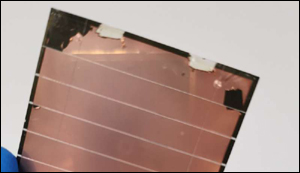All-perovskite tandem solar cells with 24.8% efficiency
9. 10. 2019 | Tech Xplore | www.techxplore.com
A team of researchers at Nanjing University in China and the University of Toronto in Canada have recently fabricated all-perovskite tandem solar cells (PSCs), a type of solar cell with a key perovskite structured component. These new solar cells, presented in a paper featured in Nature Energy, were achieve remarkable efficiency, outperforming other existing solutions.
Perovskites are a group of minerals that have the same crystal structure as perovskite, a yellow, brown or black mineral consisting largely of calcium titanate. Over the past few years, several research teams worldwide have been trying to develop solar cells using this material, typically utilizing either wide-bandgap (~1.8 eV) or narrow-bandgap (~1.2 eV) perovskites.

Fabricating all-perovskite tandem solar cells, thus combining wide-bandgap and narrow-bandgap perovskites together, could lead to a higher power conversion efficiency (PCEs) than that attained by single-junction cells without increasing fabrication costs. Researchers introduced a new chemical approach that could ultimately enhance the performance of PSCs. This approach is based on a comproportionation reaction that leads to substantial advancements in the charge carrier diffusion lengths of mixed Pb-Sn narrow-bandgap perovskites.
Read more at Tech Xplore
Image Credit: Nanjing University
-jk-




